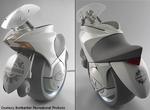I’m having some odd issues with my G5 that I’m having trouble pinning down. I’ve just tossed a plea for help out in an Apple Discussions thread, but I wanted to put it up here also in case anyone else out there has seen similar behavior.
I’ve been having an odd issue (actually, two, but they may be related) with my G5 (Dual 2.0Ghz) that I haven’t seen anyone else mention, so I thought I’d toss it out here. Unfortunately, I’m having trouble narrowing down exactly what’s going on, so this may be a tad vague.
Issue 1: My G5 appears to be an insomniac. If I leave the computer alone, it never seems to go to sleep. The screensaver will kick in, but after a while at some (apparently) random time, the screensaver kicks off as if I’d just bumped the mouse. Because of this, the machine will only go into Sleep mode if I tell it to via the Apple menu.
Issue 2 (this is the one I’m having more problems diagnosing): At some point, I lose the ability to choose some of the commands in the Apple menu: ‘About This Mac’, ‘Force Quit…’, ‘Restart…’, ‘Shut Down…’, and ‘Log Out [username]…’ are all non-responsive. All other commands in the Apple Menu work fine. Most of the time this isn’t a major issue, but when a time comes when I do need to restart the computer (for instance, after installing a Software Update), the only way I can do it is to execute a ‘sudo shutdown -r now’ through the Terminal.
I’ve tried choosing ‘Log Out…’ occasionally after a restart to pin down when the menu commands stop responding, but am having difficulties determining just what the cause is. So far, it hasn’t seemed to be related to any particular application or sequence of events.
I have noticed that it appears to happen sometime after letting the computer go through its bout of insomnia for a while. In other words, if after restarting the machine I manually tell it to Sleep, then when I wake the computer up again, I can still access all Apple Menu commands without a problem. However, if I leave the computer alone and it fails to sleep automatically as it should, at some point after that I lose the Apple Menu functionality.
Unfortunately, at this point, I can’t get any more specific than that.
Has anyone else out there seen behavior like this, or am I alone with this particular glitch?
![]()



